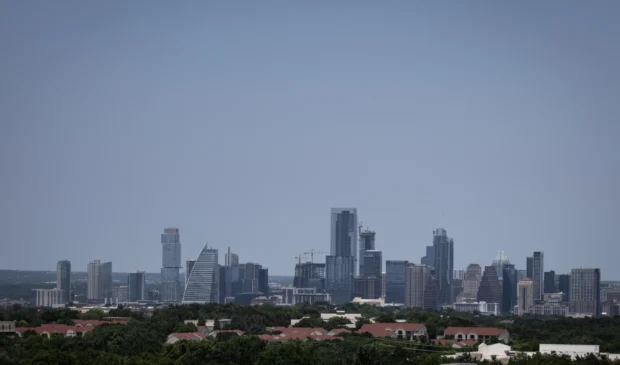Newsletter Signup
The Austin Monitor thanks its sponsors. Become one.
Most Popular Stories
- Texas Attorney General Ken Paxton sues nonprofit that serves homeless in South Austin
- Austin opens new affordable housing development in Southeast Austin
- City-owned Austin Studios found to have generated $2.6B in economic impact
- I-35 caps plan reconsidered as cost estimates soar by 61%
- SOS sues utility to protect Barton Creek Habitat Preserve
-
Discover News By District

Photo by Michael Minasi/KUT News
Smog got you down? Here’s why air quality in Austin has been so bad this spring.
Thursday, May 30, 2024 by Mose Buchele, KUT
This spring has been a challenging one in Central Texas weather-wise. There was punishing heat, destructive hail and a thick yellow-gray haze that blanketed the region.
But, of these three apocalyptic-feeling weather phenomena, the smog stands out as particularly unique. It’s been worse this year than many can remember.
Why?
The answer starts with seasonal agricultural fires in Mexico and Central America and gets a bit more complicated thanks to heat and drought.
Where there’s fire, there’s smoke – and it travels thousands of miles
Every year, farmers in the Yucatán Peninsula and neighboring regions set agricultural fires to prepare fields for new crops. Under the right weather conditions, that smoke rises high into the atmosphere and is blown across the Gulf of Mexico to settle back down over parts of Texas.
It happens most years, but this year there’s likely more smoke heading our way than usual.
Thanks to a prolonged drought in Mexico, wildfires have spread across the country. By mid-May, an estimated 168 active wildfires were burning. The smoke from many of those fires is contributing to the smog here.
“The same wind shed that brings in the agricultural burning brings in that wildfire dust as well,” said Anton Cox, air quality program manager at Capital Area Council of Governments. “That’s been part of the problem.”
Another difference this year? Once the smoke got here, it stuck around longer than usual.
For that, we can blame the stubborn spring heat.
“If we get cold fronts, that would clear out some of the haze. We just haven’t really seen that lately,” said National Weather Service meteorologist Brandon Gale. “The haze has been noticeably worse this year.”
A final reason the smog has seemed so thick has to do with humidity.
Gale said fewer dry northern cold fronts, coupled with spring rain evaporating in the heat, has made Texas air even more humid than it usually is this time of year.
That humidity has contributed to some dangerously high heat index readings. The moisture in the air has also mingled with all the smoke to further decrease visibility.
“It’s kind of a combination of the two working together,” Gale said. “They both just lingered for a long time this year.”
Dangerous air is coming earlier than usual
In a typical year, the Austin area can expect one or two days when fine particulate matter from smoke pushes its air quality into a range deemed “unhealthy for some” by air quality standards set by the Environmental Protection Agency.
This year, the region has already recorded eight such days.
“We rarely get this level this early in the year,” Cox said.
He says those “unhealthy for some” days are different from “ozone action” days. They typically don’t begin until the summer, coinciding with holidays, like the Fourth of July, when people set off smoky fireworks, or the arrival of dust blown over from the Saharan desert in North Africa.
Regardless of the cause, these days pose health risks for sensitive groups like people with asthma or lung disease.
For those groups, public health officials advise reducing outdoor time, not over-exerting yourself outdoors and making sure air conditioning filters in your home are working.
Wearing an N95 mask outdoors can also help.
“That’s the type that will actually filter out those fine particles,” Cox said.
Both Gale and Cox say the agricultural burning season in Central America is coming to an end, which should reduce air pollution from the smoke.
But June typically marks the start of Austin’s “Saharan dust” season, when that dust from North Africa starts arriving in Austin causing more haze.
So we have that to look forward to.
This story was produced as part of the Austin Monitor’s reporting partnership with KUT.
The Austin Monitor’s work is made possible by donations from the community. Though our reporting covers donors from time to time, we are careful to keep business and editorial efforts separate while maintaining transparency. A complete list of donors is available here, and our code of ethics is explained here.
You're a community leader
And we’re honored you look to us for serious, in-depth news. You know a strong community needs local and dedicated watchdog reporting. We’re here for you and that won’t change. Now will you take the powerful next step and support our nonprofit news organization?









